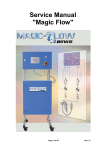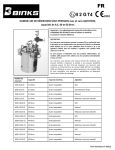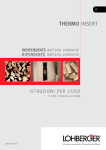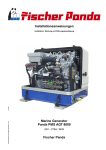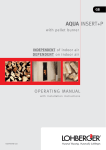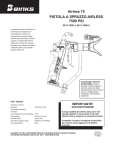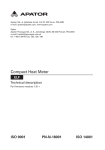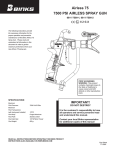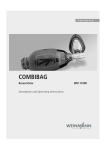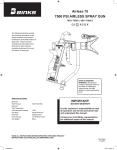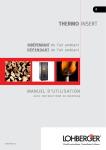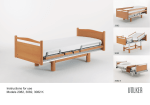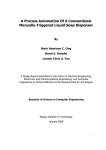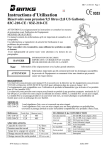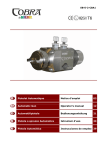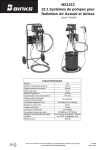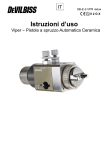Download Magic Flow English - Finishing Brands EUROPE
Transcript
Magic Flow Rev. 3.0 – Software release 02.2011 Operating instructions "Magic Flow" Page 1 of 74 Feb. 2011 Magic Flow Rev. 3.0 – Software release 02.2011 Table of contents 1 Identification data 1.1 Preface 1.2 Identification of the apparatus 1.3 Warranty Page 5 Page 5 Page 5 2 General 2.1 Notes for the user 2.2 General safety standards 2.3 Reaction hazard 2.4 Fire and explosion hazard 2.5 Toxic solvents 2.6 Injection hazard 2.7 Hazard posed by escaping liquids 2.8 Emergency shutdown 2.9 Residual pressure Page 7 Page 7 Page 8 Page 8 Page 8 Page 8 Page 9 Page 9 Page 9 3 Description of the system 3.1 Functional characteristics 3.2 Mixing 3.3 Fluid delivery Page 10 Page 10 Page 10 4 Installation 4.1 Transportation 4.2 Storage 4.3 Installation 4.4 Electrical connections 4.5 Motherboard with processor card 4.6 Pneumatic connections 4.7 Solenoid valve terminal 4.8 Fluid hose connections Page 11 Page 11 Page 11 Page 11 Page 12 Page 13 Page 13 Page 14 5 Operating the system 5.1 General 5.1.1 Turning on the apparatus 5.1.2 Numerical input 5.2 Main menu 5.2.1 Select recipe 5.2.2 Start spraying procedure 5.2.3 Start flushing procedure 5.2.4 Enter settings 5.3 Painting / mixing 5.4 Flushing 5.5 Settings 5.5.1 Recipes 5.5.2 Management of flushing 5.5.3 Valves 5.5.4 System settings 5.5.5 Calibrate / adjust K- factors 5.5.5.1 Manual adjustment of K-factors 5.5.5.2 Determine K-factors 5.5.6 Container monitoring Page 15 Page 15 Page 15 Page 16 Page 16 Page 16 Page 17 Page 17 Page 18 Page 21 Page 23 Page 24 Page 26 Page 28 Page 30 Page 33 Page 33 Page 33 Page 36 Page 2 of 74 Feb. 2011 Magic Flow Rev. 3.0 – Software release 02.2011 5.5.7 Printer configuration 5.5.8 Reports 5.5.9 V.O.C. values 5.5.10 Alarm memory 5.5.11 Security codes 5.5.12 Administrator settings 5.5.13 Optional software 5.5.13.1 Control of flushing pockets Page 37 Page 38 Page 39 Page 40 Page 41 Page 42 Page 44 Page 44 5.5.13.2 Control of agitators Page 45 6 Maintenance 6.1 Cleaning and maintenance of the fluid handling section 6.1.1 Cleaning of hoses and tubes 6.1.2 Maintenance of valves 6.1.3 Maintenance of metering cells 6.2 Cleaning of control module Page 47 Page 47 Page 47 Page 47 Page 48 7 Alarm messages and troubleshooting Page 49 8 Spare parts and options Page 52 Page 52 Page 54 Page 55 8.1 Spare parts and options in general 8.2 Control components 8.3 Components of a typical low-pressure fluid handling section 8.4 Assemblies with spare parts lists 8.4.1 Fluid valve 2K-4002 (high pressure) 8.2.3 Fluid valve CCV-403-SS-E (low pressure) 8.4.3 Volumeter 8.4.4 Air flow control 8.2.6 Accessories, fluid valve 8.4.6 Touch panel Page 56 Page 56 Page 58 Page 60 Page 62 Page 63 Page 67 Page 68 9 Decommissioning the apparatus 10 Annex 10.1 Flow chart 10.2 Connecting fluid handling section and electrical cabinet 10.3 Technical characteristics Page 69 Page 70 Page 71 Personal notes Page 72 Page 3 of 74 Feb. 2011 Magic Flow Rev. 3.0 – Software release 02.2011 EC Declaration of Conformity in accordance with EC Directives − Machinery 93/68/EEC, Annex II B, − Electromagnetic Compatibility 89/336/EEC amended by 92/31/EEC − Low Voltage 73/23/EEC The installation/machine Function: system Trade name: Type designation: Electronic 2- or 3-component mixing and metering Magic Flow 2K-2000 has been developed, designed and manufactured in accordance with the above Directives. The following harmonised standards were applied: DIN 60204-1 ZH 1/406 ZH 1/200 EN 50082-2-1993 EN 50082-2-1995 Manufacturer: ITW Oberflächentechnik GmbH & Co. KG Justus-von-Liebig-Str. 31 63218 Dietzenbach Germany André de Neergaard (Managing Director) Page 4 of 74 Feb. 2011 Magic Flow Rev. 3.0 – Software release 02.2011 1 Identification data 1 Introduction 1.1 Preface Dear Customer, Congratulations on the purchase of your new electronic multi-component apparatus. Please be assured that design and fabrication of the apparatus have been carried out according to the state of the art and with the aim of maximum user convenience and the highest safety level, based on the selection of the best materials. We wish to point out here that a thorough knowledge of how the system works along with careful study of this manual and proper operation of the apparatus only by suitably trained personnel from the start will result in more efficient operation, longer trouble-free service and faster, easier troubleshooting. For your safety please also refer to the service manuals for peripheral equipment, i.e. pumps, guns, and electrostatic equipment. If you have any questions regarding the equipment, please contact our distributors or us. We will be pleased to help you. 1.2 Identification of the apparatus If you have any questions regarding the product, please note the exact type identification of the apparatus with the serial number. You will find it on the type plate of the apparatus. This will help to identify the apparatus with regard to version and equipment so that we can offer you the appropriate assistance. 1.3 Warranty All ITW equipment and spare parts are manufactured from the best materials and using the most modern production processes. Should you still have cause for complaint, send the defective part or the defective assembly directly to ITW or to our distributor. Please understand that we cannot accept any un-franked delivery. If your warranty claim is legitimate, we will refund shipping costs to you. We will check, replace, or repair defective parts that fall within the warranty. The repair will be carried out at our company. If you wish the repair to be carried out at your site, please note that you will be charged for any travel costs that may be incurred. The warranty is rendered invalid if any malfunctions or defects occurring were caused by improper use or operation of the apparatus, or due to the accessing of assemblies for which access was not authorised. Page 5 of 74 Feb. 2011 Magic Flow Rev. 3.0 – Software release 02.2011 The warranty does not cover wearing parts that have been subjected to normal wear. These include e.g. gaskets, packings and nozzles. The warranty period will be twelve months in one-shift operation, and six months in two-shift and three-shift operation, starting from the date of initial operation, but at the latest 30 days after delivery. Any other agreements must be drawn up in writing. Page 6 of 74 Feb. 2011 Magic Flow Rev. 3.0 – Software release 02.2011 2 General 2.1 Notes for the user The safety precautions and safety standards in this section have been compiled for your safety and in your interest. For safe operation it is necessary that the user reads and understands all of the technical and safety literature and acts in accordance with it. The user must be familiar with the function of the apparatus and must be aware of the hazards and risks that may occur with pressurised pumps, hoses, and equipment. 2.2 General safety standards - DO NOT move, operate, maintain or service the apparatus before you have read and understood this service manual. If in doubt or if problems arise, contact your superior or one of our distribution partners. - NEVER leave tools or other mechanical components in or on the apparatus if it is in operation or if it is about to be started up. - NEVER exceed the maximum pressure of the apparatus. The maximum pressure of the apparatus is dictated by the component with the lowest maximum pressure. You will find the maximum pressure of the apparatus on the type plate. - When replacing components ALWAYS ensure that the new parts comply with the technical data regarding fluid and maximum pressure. - ALWAYS ensure that the spray area is properly ventilated according to legal requirements. - The equipment must ONLY be operated by authorised and adequately trained personnel who have read and understood local codes, relevant legal requirements and this service manual. The personnel must wear suitable personal protection devices and clothing and use appropriate tools during operation and maintenance. - Before carrying out any maintenance work AWAYS ensure the pressure is relieved from all air and fluid hoses. Shut off the compressed air supply to the apparatus and relieve all pumps connected to the apparatus. - Before carrying out any work in the electrical cabinet, ALWAYS ensure the current supply is disconnected. It is not sufficient that the main switch is in the OFF position. You must cut off the power supply to the cabinet completely. - When working with high-pressure spray equipment, ensure that the guns are NEVER operated without protection against accidental contact. ALWAYS activate the safety-locking lever when not using the gun, in order to prevent unintentional opening of the guns. - When finishing maintenance and repair works replace properly ALL safety covers that have been removed from moving parts. - Only use original spare parts and accessories. Failure to adhere to this renders any warranty claims invalid. - After a longer period of shutdown, check ALL relevant components for leakage and proper function. Page 7 of 74 Feb. 2011 Magic Flow Rev. 3.0 – Software release 02.2011 2.3 Reaction hazard All fluid-conducting parts of the apparatus are made of stainless steel in order to avoid possible chemical reactions. However, in individual cases a chemical reaction might occur if aggressive or chemically active media are being used, which might lead in the worst case to disintegration or even to an explosion. If you want to use such media, contact the fluid manufacturer prior to operation in order to check the compatibility of the fluid with different kinds of stainless steel. 2.4 Fire and explosion hazard caused by sparks High flow rates of non-conductive materials can lead to electrostatic charging. This phenomenon frequently appears with airless systems, because the flow rate is very high and the fluid will be sheared and ruptured at a small gap. In order to avoid charging and associated spark discharge, all components must be electrically connected to each other and earthed. Use suitable clamps and clean the contact parts of spray mist, if necessary. Connect the clamps via suitable cable to an adequate earth potential (permanently installed tubes etc.). If electrostatic charging still occurs, check for proper earthing. 2.5 Toxic solvent vapours etc. Toxic and harmful vapours may be released by the spraying and misting of paints and other materials. Follow all the manufacturer’s safety instructions. Keep to the relevant lower toxic limit values and maintain adequate ventilation. 2.6 Injection hazard - Never let any part of the body come in contact with the tip of the spray gun - Never aim high-pressure spray guns at any part of the body or at other persons under any circumstances - If the pressure is high enough, the spray jet from high-pressure spray guns can penetrate the skin. Such an injection of liquid can have serious health consequences. If such an incident occurs, in spite of all safety precautions, seek medical care immediately and inform the doctor of the nature and composition of the fluid that has penetrated (see safety data sheets). 2.7 Hazard caused by escaping liquids Never modify the connections of the apparatus without prior consultation. Regularly check the condition of hoses and connections. Take care that hoses are not crushed and bent below the permitted radius. Never subject hoses and connections to high mechanical loads in excess of those for which they are rated. Replace damaged hoses immediately! Check that all connections are tight prior to operation. Page 8 of 74 Feb. 2011 Magic Flow Rev. 3.0 – Software release 02.2011 Never try to stop or deflect leaking fluid with your hands or other parts of the body. 2.8 Emergency shutdown In case of an accident or a hazardous situation, turn the main switch to the OFF position. This will render all components on the panel currentless and will close all valves. 2.9 Residual pressure Even after interruption of the air supply to the pumps, the lines fed by the pumps are still not depressurised, as pressure can usually only be relieved in one direction. In order to depressurise the complete installation, open the spray gun and the relevant valves via the control device (if no relief device is installed at the pumps). Page 9 of 74 Feb. 2011 Magic Flow Rev. 3.0 – Software release 02.2011 3 Description of the system 3.1 Functional characteristics The system is designed to meter two or three volume flows, in which the main volume flow (generally the main component) will be opened and all other components (e.g. the hardener) will be regulated on basis of the metered first volume flow according to the mixture ratio of the chosen recipe. All parameters and tolerance values that are necessary for the calculations will be filed in the system settings. In order to guarantee maximum safety, the function of the metering sensors will be monitored on the one hand, and on the other hand the apparatus will be shut down and an alarm triggered if the required mixture ratio has not been achieved (e.g. insufficient material). Due to the high precision of the mixing and the controlled and economic handling of solvents and paint materials, the electronic mixing and metering equipment is clearly superior to mechanical metering equipment in many respects. 3.2 Mixing The apparatus regulates and injects the B component (optionally also C) into the running volume flow of side A. To obtain a good mixing result, it is necessary to connect a static mixer to the outlet of the apparatus. Care must be taken that the static mixer complies with the maximum pressure of the complete installation. The length of the mixer, the number of mix steps, and the diameter are determined by the paint material used, the mixture ratio and the maximum volume flow. It may be necessary to insert a downstream hose mixer (e.g. at very high flow rates). 3.3 Fluid delivery The fluid can be delivered either by piston pumps, double and mono-diaphragm pumps, or by pressure tanks. Care must be taken that all components are operating in a similar pressure range. So combined operation with e.g. pressure tanks and high-ratio piston pumps is not recommended. It must be ensured that the components of side B (possibly also of side C) have a pressure that is approximately 10% higher than side A, in order to be metered and fed in. For proper operation of the apparatus, the following are the minimum requirements: - a paint supply for side A a hardener supply for side B a supply of flushing agent (two are possible depending on the paint system) If necessary, a supply of thinners (for 3C installations) Page 10 of 74 Feb. 2011 Magic Flow Rev. 3.0 – Software release 02.2011 4 Installation 4.1 Transportation Depending on the design, the apparatus consists of one or two modules, which can be transported separately from each other. Transportation will be on pallets. Two people are needed to handle them. 4.2 Storage If the apparatus is to be stored, the control section must be protected against heat and humidity. In order to avoid condensation, the apparatus must not be exposed to substantial temperature changes, otherwise the apparatus must be exposed to the new ambient temperature with flaps open for several hours prior to operation. The fluid handling section is extensively resistant to external influences. For a longer period of storage, however, it should be filled with preservative oil in order to take care of the packings and to guarantee smooth operation. With regard to the supply pumps, proceed according to the relevant service manuals for the pumps. 4.3 Installation Industrial installations from ITW are normally commissioned by the company's own service technicians or our agents’ service technicians. This is to avoid faults at the very beginning caused by defective installation or operation. If installation is not to be carried out by an ITW service technician, please check the completeness and the correct function of all components within the scope of delivery. When installing always take into account the operability of the installation, the ambient conditions (e.g. EEx explosion proofing), and the safety of operators. ATTENTION: the control cabinet cannot be located in the EEx area. If operation in the EEx area is necessary, a remote control panel is available as an option. 4.4 Electrical connections The apparatus will be supplied via a central electrical input at the control cabinet. Pay attention to proper earthing of the necessary shock-proof plug. In the basic version, the fluid cabinet (fluid handling section) and the electrical cabinet will be delivered separately. The connection of the two parts should be carried out according to the description in section 10.2 (Connecting fluid handling section and electrical cabinet). Page 11 of 74 Feb. 2011 Magic Flow Rev. 3.0 – Software release 02.2011 4.5 Motherboard with processor card Key for symbols V1-V8 Outputs for control of valves 1-8 S1-S8 Status outputs, assigned as follows: S1: Mix OK S2 System ready S3 Flush S4 Fill S5 Drain valve S6 System filled S7 Alarm S8 Pot life almost expired *1 *2 *3 Page 12 of 74 Constant connection + 24 V Switching side to GND of status functions Switching side to GND of valve functions Feb. 2011 Magic Flow Rev. 3.0 – Software release 02.2011 4.6 Pneumatic connections The apparatus (in standard version) will be supplied via a central air connection. The pressure may not exceed 8 bar, but must be at least 6 bar! Please provide clean industrial air and ensure proper filtration and condensate separation. Use oil-free compressed air. 4.7 Solenoid valve terminal The solenoid valve terminal comprises 8 x 3-way, 2-position valves, which can be used for different purposes, but mainly to control the paint (?), hardener and paint (?) valves. With the maximum complement of 32 valves, 4 solenoid valve terminals are required. The outputs are assigned as described on the following page. Fig.: Solenoid valve terminal – view from below The lead colour coding for the solenoid valve terminal is follows: 4 x black= + 24 V 1 = Brown 2 = Red 3 = Orange 4 = Yellow 5 = Green 6 = Blue 7 = Purple 8 = Grey Number Valve Number Block Output at valve terminal 1 2 3 4 5 6 7 8 9 10 11 12 13 14 15 16 17 18 19 20 21 22 23 24 25 26 27 28 29 30 31 32 1 1 1 1 1 1 1 1 2 2 2 2 2 2 2 2 3 3 3 3 3 3 3 3 4 4 4 4 4 4 4 4 1 2 3 4 5 6 7 8 1 2 3 4 5 6 7 8 1 2 3 4 5 6 7 8 1 2 3 4 5 6 7 8 Page 13 of 74 Feb. 2011 Magic Flow Rev. 3.0 – Software release 02.2011 4.8 Fluid connections Depending on the number of components, the fluid handling section must be supplied with at least one main colour, one hardener and one flushing agent. The outlet of the static mixer must be connected to the gun/guns by a suitable fluid hose (please refer to length and nominal pressure). The hoses must be equipped with suitable hose connections according to the apparatus. The threads must be in a perfect condition and must seal under pressure. Page 14 of 74 Feb. 2011 Magic Flow Rev. 3.0 – Software release 02.2011 5 Operating the system 5.1 General 5.1.1 Turning on the Apparatus Turn on the apparatus by turning the main switch to the "ON" position. Only turn the apparatus on if the control cabinet is closed (high voltage). Opening of the control cabinet when the apparatus is ON must only be carried out by qualified personnel and service technicians. Generally it is not necessary to turn off the apparatus. If the apparatus is in main menu mode and has been cleaned, the screen will independently turn off after an adjustable period of time (see system settings, value "Standby"). Do not turn the apparatus off in the filled state, as control of the pot life will then no longer be possible, resulting in a risk of material hardening in the apparatus. 5.1.2 Numerical input To set the different parameters, it is necessary to be able to enter numbers. Generally this is done using the input field shown below: The value to be set is shown at the top left. The value is deleted by pressing the "DEL" key (one decimal place per key depression). The value is entered into the system by pressing the numerical fields and by pressing the "ENT field. The name of the value (here "recipe", i.e. recipe number), is described below the value. Page 15 of 74 Feb. 2011 Magic Flow Rev. 3.0 – Software release 02.2011 5.2 Main menu 5.2.1 Select recipe By pressing the recipe number (here "1") you are asked to enter a new recipe number. Possible inputs are all recipe numbers from 1 to 50. The name of the recipe is displayed below the recipe number. On the icon "Flushing", the number of the stored flushing program (1-10) for this recipe will be displayed. If you have chosen a recipe number that has been filed in recipe administration as inactive, the display with the recipe parameters will flash. You cannot start this recipe. 5.2.2 Start spraying procedure Pressing the spray icon activates the mixing procedure, provided that an active recipe was chosen beforehand. 5.2.3 Start flushing procedure Pressing the flushing icon activates the flushing procedure. The flushing procedure may be repeated as often as you wish (for example, if several spray guns are connected, which are to be cleaned one after the other). If the icon flashes, the Page 16 of 74 Feb. 2011 Magic Flow Rev. 3.0 – Software release 02.2011 apparatus has not yet been cleaned after the last mixing procedure and the remaining pot life will continue to be counted down. The pot life will only be reset to the start value after a flushing procedure has been CARRIED OUT IN FULL! The flushing program activated by the last mixing procedure will always be selected by default. It is not important, therefore, which flushing program number is displayed on the icon, but which recipe was started and stopped last. 5.2.4 Enter settings This icon will take you to the system settings. Here you can change recipes, operating parameters and safety settings for example. Depending on the setting the various sections may only be accessed using passwords. Page 17 of 74 Feb. 2011 Magic Flow Rev. 3.0 – Software release 02.2011 5.3 Painting / mixing During the mixing procedure, four different displays can be selected. By using the arrow keys on the bottom of the screen, you can change between the displays. 1 2 3 4 5 6 7 [1] The set values of the mixture ratio and the selected valves are displayed in the top line (in all displays). [2] Below this you can read the current actual values. The measured value for each component is displayed in millilitres and in percent. [3] You can read the total consumption at this position. This is important, for example, for the filling quantity of the system or for resetting the pot life. [4] Remaining pot life. The basic pot life is stored in the recipe. If not enough fluid is extracted, the pot life will run towards 00:00:00 and will subsequently set off an alarm. If the alarm is not acknowledged in time (within 5 minutes), an automatic flushing procedure will be started. IMPORTANT: In order to reset the pot life automatically, double the amount of the paint filling quantity has to be extracted from the system in order to ensure complete fluid replacement. Example: If the filling quantity is determined to be 200 ml and this is stored in the system (system settings), the pot life will always be reset to the initial value after the removal of 400 ml. [5] Using the arrow key will take you to the previous display. [6] Pressing the "Stop" key ends the mixing procedure. [7] Using the arrow key will take you to the next display. Page 18 of 74 Feb. 2011 Magic Flow Rev. 3.0 – Software release 02.2011 1 2 [1] "strokes now" = the total number of strokes of the fluid valves in this recipe since the start of the mixing procedure. The main component stays at "0" because the valve is only opened at the start and closed at the end. The number of strokes per volume provides information about the quality of the dosing. Many small hardener injections result in a better mixing result than a few large injections. [2] "strokes total" = total number of valve strokes since installation. This can be helpful when servicing the valve. Based on experience gained during operation of the system, you can draw conclusions regarding the actual condition of the wearing parts on the valve. 1 2 3 [1] Gun monitoring: the number on the display indicates the time in seconds during which the gun has been open, but no impulses were received from the metering cell. As soon as the volume sensor measures a fluid flow, the value drops back to "0". If the value increases up to the stored value for monitoring the gun, the system will set off an alarm. The gun is monitored via a sensor in the atomizer air. For automatic guns, the monitoring is carried out via a potential-free contact, which is closed by the higher-level PLC. [2] Volume flow: the bar displays the output frequency of the volume sensor. This is proportional to the measured volume flow. [3] Valve status: when the valve is activated, "ON" will be displayed on the screen, otherwise "OFF". The main component is permanently open. Page 19 of 74 Feb. 2011 Magic Flow Rev. 3.0 – Software release 02.2011 By means of this display, hardware errors can be detected easily. If, for example, the valve is "ON" but the value of the gun monitoring is increasing steadily, then the reason will be that no fluid is flowing, the metering cell is blocked or the flow sensor for the atomizer air is set incorrectly. 1 2 3 [1] Tank size: the value displays the capacity, in litres, for this container. [2] Minimum level: the programmed value indicates by which tank level the alarm will be activated. [3] Level indicator: the value displays the current fluid quantity in the tank. "No level control": the tank has not been activated for tank monitoring. Up to 8 tanks can be monitored with their own alarm output via the optional "standard level" output module. By this means, for example, eight alarm lights can be activated individually in order to see immediately which tank has to be refilled. Page 20 of 74 Feb. 2011 Magic Flow Rev. 3.0 – Software release 02.2011 5.4 Flushing 3 4 5 6 1 2 7 8 9 10 [1] Current flushing step: a flushing procedure may consist of up to 20 different steps. All flushing steps for which values are stored are run in numerical order. [2] Skip a flushing step: if the current flushing step is to be skipped, press the key and skip to the next flushing step for which values are stored. [3] Valve number: the flushing valve that is currently open is displayed. [4] Flushing value: stored set value of the flushing program, optionally in "ml" or in "sec" (see [4]). [5] Dimension: displays whether the current flushing step will be carried out in millilitres or in seconds. In principle, cleaning of the apparatus in millilitres is a more reliable process. However, quantity recording is not sensible for steps which cause e.g. air / solvent flushing. So the dimension can be determined for each flushing step separately (see flushing programming). [6] Dump valve: for each step in the flushing program it is possible to set whether the signal "Dump valve" is to be activated. The signal can then be used to activate e.g. a gun cleaning box, or whether the cleaning is to be carried out via an external dump valve (drain valve). [7] Loop start: if a loop was programmed in the flushing program, which carries out certain steps cyclically for a certain number of repeats, then the first flushing step of this loop can be displayed here. Page 21 of 74 Feb. 2011 Magic Flow Rev. 3.0 – Software release 02.2011 [8] Last step of the loop described under [7]. [9] Number of loop run-throughs (see [6]). - This key interrupts the flushing procedure and closes all valves. [10] ATTENTION: if the flushing procedure is interrupted, the apparatus is regarded as still being filled. The pot life continues to run accordingly! For the refilling and flushing of several guns, an output module is available. You can connect up to 4 dump valves or gun extractor units. If the system recognises this module during switch-on, the operator will be prompted on start-up of the spraying process to enter the spray guns that should be activated. If the system is flushed at a later stage, the flushing procedure entered is run in full once for every previously filled gun. During each run, another extractor unit is activated in order to ensure that every gun is flushed properly. Page 22 of 74 Feb. 2011 Magic Flow Rev. 3.0 – Software release 02.2011 5.5 Settings All installation parameters can be set in the tool menu. All settings can influence the mixing result and should therefore only be carried out by trained personnel or by service technicians! The option also exists of protecting all sub-menus by passwords and of informing only selected persons of these (see "Security codes"). Page 23 of 74 Feb. 2011 Magic Flow Rev. 3.0 – Software release 02.2011 5.5.1 Recipes Press the recipe key to access recipe administration (if necessary enter security code): Press the key at the top left-hand side for the recipe number to select the recipe to be edited. In the centre of the screen, you can choose any name for the recipe with up to 15 characters. This name will be displayed in the main menu under the recipe number. This will make it easier for you to assign the recipes to the associated colours. In the table, top right, a fluid valve can be allocated to each metering channel (A / B / C) for the selected recipe and the fluid ratios for the recipe can be determined. Please note that the volumetric mixture ratio will be entered. It is of no importance whether, for example, for "A" 4 portions and for "B" 1 portion are entered, or whether the mixture ratio will be entered e.g. as 100: 25. During the mixing procedure the main component will automatically be determined by the greatest share of the total mixture and permanently opened, while the other components will be added by metering. Only enter values under "C" if the apparatus is also equipped as a 3C installation. Ensure that the valve numbers entered are actually connected to the relevant metering cells. Page 24 of 74 Feb. 2011 Magic Flow Rev. 3.0 – Software release 02.2011 Adjust the pot life of the relevant mixture under t(min) (in minutes). If an automatic pressure adjustment kit (optional) is connected to the apparatus, you can determine the fluid pressure under p(bar), which will be adjusted after filling. Under Flush, enter the flushing program that should be assigned to this recipe. You can select one of the ten flushing programs that you set up earlier. Under Active you can determine whether it is an active recipe that can be started immediately. You can release recipes to the operator or block them in this way. Inactive recipes will flash when they are selected in the main menu and cannot be used. The icon with the crossed out disk rejects all modifications and downloads all 50 recipes again from the system memory. The icon with the disk stores all modifications and takes you back to the tool menu. ATTENTION: both when aborting and saving, the control unit requires a few seconds either to write the data of 50 recipes to the EEprom or to read them from the EEprom. For this reason, do not try UNDER ANY CIRCUMSTANCES to speed up this process by pressing especially hard on the display! Page 25 of 74 Feb. 2011 Magic Flow Rev. 3.0 – Software release 02.2011 5.5.2 Management of flushing Press the flushing program key to access management of the flushing process (if necessary enter security code): First you are asked to enter the number of the flushing program that you wish to edit. You can enter the numbers 1 to 10. 3 4 5 6 2a 1 2b 7 8 9 10 [1] Current flushing step that is being processed: a flushing procedure may consist of up to 20 different steps. Only those flushing steps for which values are stored are run in numerical order. [2a] / [2b] Flushing step forward, flushing step back: changes to previous or next flushing step that is to be processed. [3] Valve number: number of the flushing valve which is to be opened in this step. [4] Flushing value: set-point value of this step, which must be processed so that the apparatus skips to the next step, optionally in "ml" or in "sec" (see [4]). [5] Dimension: displays whether the current flushing step will be carried out in millilitres or in seconds. In principle, cleaning of the apparatus in millilitres is a more reliable process. However, quantity recording is not sensible for steps which cause air / solvent flushing for example. So the dimension can be determined separately for each flushing step. Page 26 of 74 Feb. 2011 Magic Flow Rev. 3.0 – Software release 02.2011 [6] Dump valve: for each step in the flushing program it is possible to set whether the signal "Dump valve" is to be activated. The signal can then be used to activate e.g. a gun cleaning box, or whether the cleaning is to be carried out via an external dump valve (drain valve). [7] Loop start: in the flushing program a loop can be programmed, which carries out certain steps cyclically for a certain number of repeat options. Here the first step of this loop will be displayed. [8] Last step of the loop described under [7]. [9] Number of loop run-throughs (see [6]). [10] - Key to store all modifications. Page 27 of 74 Feb. 2011 Magic Flow Rev. 3.0 – Software release 02.2011 5.5.3 Valves Press the valve key to enter the manual control panel for the associated valves, signal outputs (optional), and pressure regulator (optional): Keys 1- 8 (alternatively 1-16 or 1-32, depending on system configuration) control the relevant valves. For security reasons only one fluid valve can be opened at a time. If you want to close all valves again, press the key "Valves OFF". Keys "S1" - "S8" control the special signals: S1: Mixing OK S2: Ready S3: Flushing S4: Filling S5: Dump valve S6: Filled S7: Alarm S8: Alarm prior to expiry of pot life Press the key “Signals OFF” to turn off all outputs. Keys "F1" - "F4" control gun extractor units 1 to 4 Keys "D1" - "D4" control colour distributor valves 1 to 4 You can test the optionally available pressure adjustment kit using the analogue regulator. With "-" you reduce the value by 0.1 bar, with "+" you increase the value by Page 28 of 74 Feb. 2011 Magic Flow Rev. 3.0 – Software release 02.2011 0.1 bar. With "Analogue OFF" you reset the value to 0.0 bar. The kit performs adjustments from 0.0 to 7.0 bar. Page 29 of 74 Feb. 2011 Magic Flow Rev. 3.0 – Software release 02.2011 5.5.4 System settings Important security-related settings for the operation of the apparatus can be entered in the system settings. The correct setting of these parameters is of great importance for the resulting finish and trouble-free operation of the apparatus. Filling quantity: on the one hand, the filling quantity is important for the external signal "Filling" to which e.g. a signal light can be connected, which indicates to the operator that the filling procedure is not yet complete. On the other hand, the filling quantity is needed to monitor the pot life. After the removal of twice the filling quantity, the pot life will be reset to the start value. Removal of twice the filling quantity is necessary to prevent mixing of already reacting and fresh fluid in the apparatus and in the hoses. Increment size: the increment size is necessary for monitoring the accurate mixing of the fluid. The stored value indicates the maximum interval between two hardener metering injections in millilitres. Important: this value has no effect on the quality of mixing! It only serves a monitoring function. The apparatus itself tries to meter the hardener in the smallest possible injections. The cycle Page 30 of 74 Feb. 2011 Magic Flow Rev. 3.0 – Software release 02.2011 frequency of the valve depends on hardener overpressure, the needle stroke of the metering valve, flow rate, viscosity and many other factors. Generally the increment size should be adjusted in such a way that mixing of the fluid in the mixer can just take place. An increment size of 100 ml for a static mixer with a filling volume of 20 ml may have the result that the fluid will not be mixed accurately, but that the apparatus continues to operate without any error signal. Metering cell monitoring: the value stored here indicates for how long the spray gun may be opened without the metering cell having to move. Monitoring of the gun opening in manual installations is generally carried out by the air flow control integrated into the atomizing air. For automatic installations this signal can also be given directly by an external control facility. When the painter opens the gun, the fluid flow should start shortly afterwards and activate the gear wheels of the metering sensors. As long as a movement is recognised and impulses are thus sent by the metering cells to the mixing apparatus controller, monitoring of the metering cells is reset. However, if a metering cell is blocked because of contamination, for example, so that it can no longer detect a volume flow, the apparatus will emit an alarm signal after the time set here. The time should be in the range of 5-10 seconds in order to ensure that no unmixed fluid can escape from the gun. The time chosen should not be too short (less than 3 seconds), however, since the painter occasionally uses the gun to blow dust from the object to be coated. Time: press the [SET CLOCK] key in order to set the internal clock of the apparatus. The clock has a power reserve of approximately 10-14 days. The clock is necessary to print logs and for storing alarm messages. To change values press the keys [+] / [-]. To store the modifications press the [OK] key. Display brightness: enter the value for the relative display brightness in percent (0- 100%). Please note: if the value is too low you might not be able to read the displays and will then not be able to increase the value! Standby time: the standby time in seconds indicates the time period after which the display turns off to extend the service life of the lighting cathode. The apparatus only switches to standby mode if it is flushed and if it is in main menu mode (all valves closed). Page 31 of 74 Feb. 2011 Magic Flow Rev. 3.0 – Software release 02.2011 If the apparatus is in standby mode, it is sufficient to touch the screen to return to the main menu. Units of measurement: pressing the appropriate button sets the system either to metric units (ml / l / bar) or to imperial units (oz / gl / psi). Recalculation is automatic. Language settings: Up to eight different language packages can be installed on the system. The composition and positioning of the languages can vary. Important: a language must always be installed. If no language package is specified, please contact us. After selecting the desired language, please be patient - the language first has to be loaded. Page 32 of 74 Feb. 2011 Magic Flow Rev. 3.0 – Software release 02.2011 5.5.5 Calibrate / adjust K- factors 5.5.5.1 Manual adjustment of K-factors For quick start-up of the apparatus and for checking the functions generally, it is normally sufficient to enter the K-factors of the volumeter determined by the design into the system. These are normally entered on delivery of the apparatus. To take account of the different physical characteristics of the media to be metered, a dedicated K-factor can be entered for each valve and thus for each associated medium. A high-viscosity, solvent-based paint will produce a different K-factor from a cleaning thinner or a water-based paint at the same volumeter. Press the individual number fields (1 – 32) to read the stored value. If you wish to change this value (e.g. after changing to another volumeter), you can do so by . pressing the number input icon 5.5.5.2 Determining K-factors To increase the accuracy of the mixing apparatus, it is recommended that all media be calibrated. To do this, proceed as follows: Press the icon with the mixing cup ( ) Page 33 of 74 Feb. 2011 Magic Flow Rev. 3.0 – Software release 02.2011 Select the volumeter that is to be calibrated: 3. Select the valve that is to be used for calibrating: Page 34 of 74 Feb. 2011 Magic Flow Rev. 3.0 – Software release 02.2011 4. Carry out metering: - - - - The bar on the left side indicates the flow rate. If the bar does not expand upwards when removing fluid, you have either selected a valve which is not allocated to the selected volumeter, or the metering cell is mechanically blocked. The number top right indicates the number of pulses. First open the spray gun and remove fluid. The pulse counter must now display an increasing value. Using the "START / RESET" key you can reset the pulse counter to zero. After filling the system with fluid, press the key, wait for a few seconds and then start the actual metering. Remove an easily readable quantity of fluid into a metering cup. Then close the spray gun and wait for a few seconds until the pulse counter has come to a stop. Finally, press the "OK" key. You will then be asked to enter the volume of the fluid removed. The resulting K-factor will be displayed and will then be entered into the system. Page 35 of 74 Feb. 2011 Magic Flow Rev. 3.0 – Software release 02.2011 5.5.6 Container monitoring Integrated container monitoring serves to check the container levels without any additional sensor systems. If a container is to be monitored, its level must be stored in this menu prior to use. Starting from the consumed quantity of fluid metered, the system can emit an alarm signal if a defined minimum level is reached in order to avoid no-load operation of the pumps, with resultant defective mixtures and operating failures. The container that is to be set or monitored is selected using the buttons [1] – [32]. The container size present when delivered is set using the button [MAX LEVEL]. [ACTUAL CONTENT] displays the current container level. Press the button to refill the container numerically or to enter any new level. [MIN LEVEL] displays the minimum level. An alarm signal will be triggered if the level falls below this value. Press the button to adjust the level. [ACTIVE] and [NOT ACTIVE] indicate whether monitoring is to be activated. If the button is in [ACTIVE] mode, an alarm signal is emitted. If the button is in [NOT ACTIVE] mode, the container level will be calculated, but the minimum level will be ignored. Page 36 of 74 Feb. 2011 Magic Flow Rev. 3.0 – Software release 02.2011 5.5.7 Printer configuration [UNIT ID] displays the name of the mixing apparatus which appears on the print-outs. It is therefore possible to distinguish between the print-outs of different apparatus. The name can have up to 10 characters. [PRINTING AFTER …ml] displays the intervals at which process information is to be printed. In the above case, a print-out would be started after the removal of one litre of fluid in each case. [PRINTING AFTER …sec] displays the time intervals at which a print-out is to be printed during the mixing procedure. It is possible to activate both print-out variants, but also only one or neither of them. If no print-outs are to be produced, set both values to "0". Set the following parameters at the printer interface that is provided as standard (serial): Baud: 9600 (8 bit / no parity / 1 stop bit), no hardware handshake Page 37 of 74 Feb. 2011 Magic Flow Rev. 3.0 – Software release 02.2011 5.5.8 Reports Use the keys [1] to [32] to select the valve and component respectively where you wish to read the consumption. [TOTAL] displays the total consumption of the component since installation of the system. It is not possible to reset this value. [JOB] displays the consumption since the last reset of this value. It is possible to record weekly consumption, for example. The operator can reset these values using the key [RESET JOB]. The consumption of the component and its VOC content is listed both at the total consumption meter and at the job meter. The relative VOC content in percent can be set in the VOC Menu (see 5.5.9). Press the key [PRINT ALL] in order to print the consumption values of all components if the optional printer is connected. Page 38 of 74 Feb. 2011 Magic Flow Rev. 3.0 – Software release 02.2011 5.5.9 V.O.C. values Press the keys [1] to [32] to select the valve and component respectively for which you wish to adjust the VOC value. The VOC value (in %) will be displayed in the centre. Press the key [V.O.C.] to adjust the value for each valve separately. The value is needed in order to calculate not only the consumption but also the VOC emissions for the consumption reports. Page 39 of 74 Feb. 2011 Magic Flow Rev. 3.0 – Software release 02.2011 5.5.10 Alarm memory The mixing apparatus stores up to 100 alarm messages in order of appearance. You can browse the alarm history with the keys [ ] and [ ]. If more than 100 errors were recorded, the last 100 messages are still available. Each alarm message is listed with date and time as well as the reason for the alarm. You will find the meaning of the alarm icons in the chapter "Alarm Messages". Page 40 of 74 Feb. 2011 Magic Flow Rev. 3.0 – Software release 02.2011 5.5.11 Security codes When delivered all menus are accessible without code input (input "0"). After installation and commissioning, all security-related settings should be passwordprotected against unauthorised access. Passwords are set in the same manner as any adjustment of the codes that may be required later. To set a code, first press the key icon shown above. You will be asked to enter the “master code”, which for reasons of security is not part of this documentation. It will be sent separately to you from ITW / Binks. After entering the code, press the field for which you want to secure the menu with a new password. You will see the input mask "new code". Enter your new secret number here. The code will be stored automatically. If you should forget or mislay your access code, you can also use this procedure to find out the stored code. But keep the master code safe, because it is an unchangeable part of the control software. Page 41 of 74 Feb. 2011 Magic Flow Rev. 3.0 – Software release 02.2011 5.5.12 Administrator- settings This menu contains settings that should only be changed by service technicians. You will be given the access code if required on request. ACCESS TIME: the time shown in seconds indicates that in apparatus with a robot communications kit (for which it is assumed that these are operated via external control), access via touchscreen must be confirmed once more within the time indicated to prevent mistaken commands. ALARM FLUSH: time after which a flushing process is triggered automatically in case of an alarm. 0 sec. = no forced flushing COL. Ch. FLUSH: indicates whether automatic interim flushing takes place. OFF = no interim flushing, RECIPE = changing recipe, 1C-2C-3C only when changing paint type (thus from 1C to 2C paint). COM-1 BAUD RATE: speed of serial interface. The value must be set to 57,600 for the optional Ethernet interface. For serial printers 19,200 Baud is normally used. COM-1 FUNCTION: printer = data that are output on a printer are printed automatically. Web server = data are only output on request (strictly according to communications protocol). Screenshot = the receipt of any byte results in the return Page 42 of 74 Feb. 2011 Magic Flow Rev. 3.0 – Software release 02.2011 of the screen contents in an internal format. The data must be received with a special tool and converted into a bitmap (*.bmp). COM-2 BAUD RATE: see above, only relevant if there is an optional second interface. D/A-PORT FUNCTION: function of analogue output. 0-7bar = pressure adjustment kit. 0-1.0l/min = the current flow rate is output in the range up to 1.0 l/min (10V = 1.0 litre/min). 0 – 5.0l/min = same function, but 10V corresponds to a flow rate of 5 litre/min. 1st POT LIFE ALARM: pot life pre-alarm in minutes. STOP AFTER FILLING: indicates whether the apparatus closes the valves once again after filling, ready to be released once more. POT LIFE FACTOR: safety factor for calculating the remaining pot life. 200% means that double the filling quantity must be consumed to reset the pot life again to the initial value. 150% means accordingly e.g. 1.5 times the filling quantity. Page 43 of 74 Feb. 2011 Magic Flow Rev. 3.0 – Software release 02.2011 5.5.13 Optional software (only available for additional hardware options) 5.5.13.1 Control of flushing pockets If the option for the control of up to four flushing pockets for handguns is connected to the system, the following screen will appear after pressing the “Spray” key: Guns 1 to 4 can be activated or deactivated individually (on = active / off = inactive). The filling process will then be performed consecutively via the corresponding flushing pocket for each activated gun. When changing paints or flushing the system, only the guns that were active during the last spraying process will be cleaned one after the other. The stored flushing process will then run exactly once for each gun. This mask will only be called up if the spraying process is started via the display. If the mixing process is called up via a remote control or a robot communication module, the last selected gun combination will be automatically applied again. Page 44 of 74 Feb. 2011 Magic Flow Rev. 3.0 – Software release 02.2011 5.5.13.2 Control of agitators If the option for control of up to sixteen agitators is connected to the system, these can be programmed as follows: The function of each agitator can be tested in the programming menu. All agitators can be set individually and independently of one another to OFF / LOW / HIGH. LOW and HIGH each describe just one digital output. Assigning these outputs to electric motors or solenoid valves is down to the user. The outputs can also be used to repump fluid in circulation etc. The values of LOW OFF and LOW ON describe the cyclical turning on and off of the relevant outputs, regardless of the operating mode of the apparatus. The HIGH ON time shows the time taken to turn on the relevant output before the start of the mixing procedure. LOW OFF TIME: indicates how many seconds the output is turned off for. LOW ON TIME: indicates how many seconds the output is turned on for. All agitators are always turned on and off at the same time. Example: LOW OFF = 3000sec / LOW ON = 600sec All agitators are turned on for 10 minutes and off for 50 minutes every hour. Page 45 of 74 Feb. 2011 Magic Flow Rev. 3.0 – Software release 02.2011 HIGH ON: the mixing process is started with one component; this is first agitated for the set time. Only then are the metering valves opened. This always applies only to the agitators whose components are stored in the activated recipe. Page 46 of 74 Feb. 2011 Magic Flow Rev. 3.0 – Software release 02.2011 6 Maintenance 6.1 Cleaning and maintenance of the fluid handling section Protect the fluid handling section from spray mist. If it is necessary to clean the area with thinners, the power to the apparatus must be turned off because the metering sensors of the standard version are not EEx-proof. Generally the apparatus must be cleaned by a complete flushing procedure after the end of operations or during a prolonged spray interval to avoid hardening of the paint in the apparatus. See 5.2.3 Start flushing procedure 6.1.1 Cleaning of hoses and tubes If the flushing procedures have been carried out properly, a special cleaning of hoses and tubes is not necessary. However, if reactions occur inside the system, replacement is advisable to avoid solid particles gradually coming off and entering the system. 6.1.2 Maintenance of valves If a colour change valve has not been used for a prolonged period, disassembly of the colour supply unit and flushing of the valve are recommended, otherwise solid particles might settle inside the valve. If the valves no longer operate properly, or if air or fluid leaks occur, the seals must be replaced. Since the hardener valves are activated more frequently, regular checking of the valves is indispensable. Servicing of valves at regular intervals is recommended once initial empirical values have been obtained. You will find further details in Annex 10.5. 6.1.3 Maintenance of metering cells In principle our metering cells are maintenance-free. If it should be necessary to clean blocked metering cells, however, please note: Metering cells have to be handled according to the manufacturer's instructions - see annex (10.4). The accuracy of the metering cells must be checked at regular intervals (calibration), because the use of abrasive or pigmented media will cause wear, which affects the accuracy of the gear wheels. Page 47 of 74 Feb. 2011 Magic Flow Rev. 3.0 – Software release 02.2011 6.2 Cleaning of control module The control module must only be cleaned with mild cleaning agents. There are no internal components or assembly groups which need cleaning or maintenance. Cleaning the touchscreen display with solvents is not allowed. If you are concerned about extensive contamination of the display, slightly self-adhesive transparent protective films are available, which can easily be replaced. Page 48 of 74 Feb. 2011 Magic Flow Rev. 3.0 – Software release 02.2011 7 Alarm messages and troubleshooting Fault Alarm message: Possible cause Atomizing air is open without spraying Remedy Set longer activating time for metering cell monitoring. Do not open atomizing air unnecessarily Clean tip, replace if necessary Check allocation of colour change valves to solenoid valves (no volume flow, A side) Tip clogged (no fluid flow with gun open) Colour change valve connected to wrong solenoid valve (no trigger air signal) Colour change valve does Disassemble colour not open although trigger change valve, clean, air is applied replace seals (see service manual for valve) Lack of fluid Check fluid delivery system on A side (empty container?) Defective feed pump Check functioning of pump (see service manual of pump) Blocked metering cell Start flushing procedure, disassemble metering cell and clean if necessary Defective sensor on Contact service metering cell technician, replace metering cell Cable rupture or wrongly Test cable, replace if connected necessary Page 49 of 74 Feb. 2011 Magic Flow Rev. 3.0 – Software release 02.2011 Fault Alarm message: Possible cause Atomizing air is open without spraying Remedy Set longer activating time for metering cell monitoring. Do not open atomizing air unnecessarily (no volume flow, B or C side) Hardener pressure too low Set hardener pressure to pressure of main colour + approximately 10% Clean tip, replace if necessary Check allocation of colour change valves to solenoid valves Tip clogged (no fluid flow with gun open) Colour change valve connected to wrong solenoid valve (no trigger air signal) Colour change valve does Disassemble colour not open although trigger change valve, clean, air is applied replace seals (see service manual for valve) Lack of fluid Check fluid delivery system on B side (empty container?) (alternatively C side) Defective feed pump Check functioning of pump (see service manual of pump) Blocked metering cell Start flushing procedure, disassemble metering cell and clean if necessary Defective sensor on Contact service metering cell technician, replace metering cell Cable rupture or wrongly Test cable, replace if connected necessary Page 50 of 74 Feb. 2011 Magic Flow Rev. 3.0 – Software release 02.2011 Fault Alarm message Possible cause Pressure differences too small (added components do not enter mixture) Recognisable through lack of injection noise Remedy Slowly increase hardener pressure, increase needle stroke at metering valve Uneven operation of feed Check pumps, clean and pumps replace packings if necessary Increment size selected Adjust increment size too small within the possibilities. (Mixing tolerance A/B/C exceeded, only for components that are added) (Mixing tolerance A/B/C exceeded, only for components that are added) Fault Alarm message (Pot life expired) Flow rate too high (for example by filling without spray tip) Adjust increment size within the possibilities. Only fill with tip. Pressure differences too high (added components enter mixture with too great an injection) Recognisable from pulsing Slowly reduce hardener pressure, reduce needle stroke at metering valve Uneven operation of feed Check pumps, clean and pumps replace packings if necessary Increment size selected Adjust increment size too small within the possibilities. Flow rate too high (for Adjust increment size example by filling without within the possibilities. spray tip) Only fill with tip Possible cause Apparatus has not been flushed in good time Remedy Start flushing procedure Insufficient fluid removed Start flushing procedure from apparatus within pot life period Page 51 of 74 Feb. 2011 Magic Flow Rev. 3.0 – Software release 02.2011 8 Spare Parts and Options 8.1 Spare parts and general options Item No.: Description Merchandise Group Basic Installations Magic Flow 2K-2000 2K-2001 2K-2002 Magic Flow, electronic 2-component mixing and metering apparatus; electronic control cabinet, 600 x 380 x 350 mm with touchscreen, pneumatic / hydraulic control cabinet, 600 x 700 x 210 mm, equipped for 1 main colour, 1 hardener, 2 flushing agents, metering range: 50 - 2000 ml/min per component, pressure-resistant up to 10 bar (LP) or 250 bar (HP), incl. 1 static mixer Stand post, aluminium profile construction for 2-C apparatus, height:1500 mm, depth: 400 mm; control cabinets can be mounted with height adjustment Wheels set, 2 x castors, 75 mm, antistatic, 2 x castors, antistatic, with double lock-up brake, completely mounted Merchandise Group Electronic Magic Flow 2K-3004-1 Expansion module for valves 9-16 for fitting on top hat rail 2K-3004-2 Expansion module for valves 17-24 for fitting on top hat rail 2K-3004-3 Expansion module for displaying filling levels of 8 containers (Minimum value check) 2K-3004-5 Expansion module for control of up to 4 gun extractor units 2K-2049 Switching power supply 230VAC / 24VDC/3.2A, 75W, top hat mounted 2K-2073 Line safety switch, characteristics: B16 2K-3050 Motherboard, supplied without display or processor card 2K-2051 Processor for motherboard, chip set Siemens Infineon CI144 preprogrammed 2K-2052 Touchscreen, LCD display with analogue touch field, 240 x 128 pixels, CFL lighting, blue / white; pre-programmed for "Magic Flow" 2K-2064 Air flow control, adjustable, air connections: 3/82 (F) 24 V power supply, signal output 24V (PNP switching) Page 52 of 74 Feb. 2011 Magic Flow Rev. 3.0 – Software release 02.2011 Merchandise Group Spare Parts Magic Flow 2K-3011 Solenoid valve terminal, 24 VDC with 8 x 3-way, 2-position valves 2K-3012 Solenoid valve, 5-way, 2-position with coil 24 VDC and cable 2K-2071 "Magic Flow" integrated gauge, 0-10 bar, 40 mm, front mounting 2K-2070 "Magic Flow” air regulator, "3/8" air regulator, range of adjustment 0-10 bar Merchandise Group Fluid Part Magic Flow 2K-2015 2K-2016 "Magic Flow" volumeter Volumeter, stainless steel 1/4" (F), P(max) 250 bar, metering range 502000ml/min, slide bearing "Magic Flow" single pickup Pickup for volumeter, not EEx-proof, connection M12, four conductor 2K-2017 "Magic Flow" single pickup, EEx Pickup for volumeter, EEx-proof, connection M12, four conductor 2K-2018 Section switch amplifier Section switch amplifier for volumeter, 1-channel design for top hat 2K-2019 Pair of "Magic Flow" gear wheels Pair of gear wheels incl. slide bearing bush, ca. 8,800 pulses/litre 2K-2020 "Magic Flow" shaft volumeter 2K-2021 Volumeter connection cable with plug, 5m, yellow 2K-2084 Volumeter cable, (sold by metre), colour yellow 2K-2068 Volumeter cable, (sold by metre), colour blue Merchandise Group Options Magic Flow 2K-2006 2K-2007 2K-2008-1 "Magic Flow" EEx-proof kit Conversion kit for "Magic Flow", includes: 2 x EEx sensors for volumeter (in exchange for standard sensors), 1 x EEx solenoid valve (5m cable), 2 x section switch amplifiers Robot communication kit 8 x optoelectronic coupler inputs 8 x optoelectronic coupler outputs In top hat housing, for connection to PLC bus, cable length max.: approx. 1m "Magic Flow" transceiver unit for PLC bus - without cable - for the connection of external PLC modules for a distance of more than one metre Recommended cable for connecting the units: CAT5 / CAT6 network cable, twisted pair, shielded Page 53 of 74 Feb. 2011 Magic Flow Rev. 3.0 – Software release 02.2011 2K-3008 Top hat rail transceiver 2K-3026 Remote control non-Ex with recipe display (also required:1 x Transceiver Kit 2K-2008-1 and 1 x top hat rail transceiver 2K-3008 2K-3047 Remote control Ex (Category 2) with recipe display (also required:1 x Transceiver Kit 2K-2008-1 and 1 x top hat rail transceiver). 2K-2010 Pneumatic remote control for Magic Flow 3 functions: Start / Stop / Flushing 3 x P/E converters and 3 x pneumatic buttons 2K-2072 Magic Flow isolated assembly (2 x metering cells) Dual pick-up for metering cell with fibre optic output, fibre optic cable (5m), fibre optic receiver and lithium battery. EEx-proof. Two sets each, including an external solenoid valve, which will be installed as close as possible to the fluid part, but outside the high voltage area. 8.2 Control components Item 1 2 3 Name Touchscreen Processor card Motherboard Page 54 of 74 Part number 2K-2052 2K-2051 2K-3050 Feb. 2011 Magic Flow Rev. 3.0 – Software release 02.2011 8.3 Components of a typical low-pressure fluid handling section (1 main colour, 1 hardener, 2 cleaning agents) Item Name 1 2 3 4 5 6 7 Main colour valve Cleaning agent valve Cleaning agent valve Hardener valve Return valve Mixing pipe Pickup metering cell 8 Gear wheel metering cell Page 55 of 74 Part number CCV-403-SS CCV-403-SS 2K-4002 2K-4002 2K-2027 2K-2080 2K-2016 (Non-EEx) 2K-2017-A (EEx) 2K-2015 Feb. 2011 Magic Flow Rev. 3.0 – Software release 02.2011 8.4 Assemblies with Spare Parts Lists 8.4.1 Fluid valve 2K-4002 (high pressure) Materialventil 2K-4002 Lfd Nr Stück Benennung und Fertigmaße Werkstoff Zeichnungsnummer Bemerkung Änderung Datum Name Gezeichn. Gehört zur Zeichnung Geprüft Normeng. Maße ohne Toleranzangabe nach DIN ISO… Maßstab Materialventil Ersatz für Diese Zeichnung wurde mit CAD erstellt und muß mit CAD geändert werden. Serial no. Item Name and finished dimensions Material Drawing number Comment Change Date Name Drawn Belongs to drawing Checked Standard compliant Dimensions without tolerance info as per DIN ISO … Scale Material valve Replacement for This drawing was produced using CAD and must be amended using CAD. Page 56 of 74 Feb. 2011 Magic Flow Rev. 3.0 – Software release 02.2011 Item Quantity Unit Name 1 2 3 4 5 6 7 8 9 10 11 12 13 14 15 16/17 1 1 1 1 1 2 1 4 1 2 1 1 1 1 1 1 Piece Piece Piece Piece Piece Piece Piece Piece Piece Piece Piece Piece Piece Piece Piece Piece Valve body Air cylinder Cap Piston Nut Spacer Packing holder Socket head cap screw Sealing ring Sealing ring Fastening screw Compression spring Compression spring O-ring O-ring Seal kit 18 21 27 28 1 1 1 1 Piece Piece Piece Piece Seal kit recommended for hardener valve Valve needle Locking piece with valve seat Screw plug O-ring 29 4 Piece Spring washer Page 57 of 74 Standard code designation Comment 2K-4100 2K-4101 2K-4102 2K-4103 2K-4104 2K-4105 2K-4106 2K-4107 2K-4108 2K-4109 2K-4110 2K-4111 2K-4112 2K-4113 2K-4114 2K-4115 M4 x 40 DIN 912-8.8 vz 12 x 16 x 1.5 14 x 18 x 1.5 G¼ 25.3 x 2.4 3.3 x 2.4 3xsleeve, graphite coated/3xO-ring Viton 3xsleeve PTFE/ 3xO-Ring Viton 11/16" x 1 6 UN G¼ Ø 10 x 2 Viton or Ø 10 x 2 Viton FEP-sheathed 4A, DIN 7980 vz 2K-4115-1 2K-4116 2K-4117 2K-4118 2K-4119 2K-4119-FEP Feb. 2011 2K-4120 Magic Flow Rev. 3.0 – Software release 02.2011 8.4.2 Fluid valve CCV-403-SS-E (low pressure) Page 58 of 74 Feb. 2011 Magic Flow Rev. 3.0 – Software release 02.2011 Page 59 of 74 Feb. 2011 Magic Flow Rev. 3.0 – Software release 02.2011 8.4.3 Volumeter 2K-2015 Einzelaufnehmer Single pickup Page 60 of 74 Feb. 2011 Magic Flow Rev. 3.0 – Software release 02.2011 Volumensensor Wahlweise Sitz des Einzelaufnehmers Einlass Auslass Ansicht Anschlussbild Befestigungsschraube Volume sensor Optional seat of single pickup Inlet Outlet View Mounting face Fastening screw Spare parts for volumeter 2K-2015 The following spare parts and wear parts are available for the volumeter: Pair of gear wheels 2K-2019 Shaft gear wheel 2K-2020 Disc washer (material PTFE) 2K-2057 or Disc washer (material Viton, FEP-sheathed) 2K-2058 Other volumeters are available on request (higher or lower resolutions, various bearings). Page 61 of 74 Feb. 2011 Magic Flow Rev. 3.0 – Software release 02.2011 8.4.4 Airflow control for atomizing air LG 518 GSP – part no. 2K-2053 PNP Ausgang Analog-Ausgang LED Anzeige Lufterfassungsbereich 0,5…15 m/s Ausführung Abmessungen Erfassungsbereich PNP output Analog output LED display Air detection range 0.5…15 m/s Design Dimensions Detection range Page 62 of 74 Feb. 2011 Magic Flow Rev. 3.0 – Software release 02.2011 Ausgang Best. Nr. Typ Schaltstrom Last Betriebsspannung Stromaufnahme Umgebungstemperatur Temperaturgradient Bereitschaftszeit Reaktionszeit typ. Gehäusewerkstoff Anzeige Strömung Schutzart Anschluss 2 m PVC-Kabel, 3x0,5 mm2 Output Order no. Type Switching current Load Operating voltage Power consumption Ambient temperature Temperature gradient Standby time Typical reaction time Casing material Flow display Protection type Connection 2 m PVC cable, 3x0.5 mm2 Page 63 of 74 Feb. 2011 Magic Flow Rev. 3.0 – Software release 02.2011 8.4.5 Accessories, fluid valve Hochdruckventil CCV300 High-pressure valve CCV300 Serial no. 1 2 3 4 Piece 1 1 1 5 6 7 8 4 9 4 10 4 11 4 12 13 4 Name and finished dimensions End plate push-fit fitting Adapter End plate G 1/4i O-ring Hex. socket screw M4 x 40 Blanking plug Plug G 1/4i Clamping screw M5 x 16 IP1+31 Clamping screw M5 x 60 IP1, 1x2+31 Clamping screw M5 x 100 IP1, 2x2+31 Clamping screw M5 x 140 IP1, 3x2+31 Spring washer A5 O-ring Page 64 of 74 DIN Material 14305 14305 14305 Ø 10 x 2 Viton Farbwechselsystem or CCV300 Ø 10 x 2 Viton FEP-sheathed 931 8.8-vz Comment 2K-4121 2K-4122 2K-4123 2K-4119 2K-4119-FEP 2K-4125 912 14305 14305 8.8-vz 2K-4126 2K-4127 2K-4128 912 8.8-vz 2K-4129 912 8.8-vz 2K-4130 912 8.8-vz 2K-4131 7980 Ø 10 x 2 Viton or Ø 10 x 2 Viton FEP-sheathed 2K-4132 2K-4119 2K-4119-FEP Feb. 2011 Magic Flow Rev. 3.0 – Software release 02.2011 2K-2027 Return valve 1/4” BSP M16x1.5 2K-2029 Colour change stack, 2 + 2. (until 2007) 2K-2030 2K-2031 Colour change stack, 4 + 2. Colour change stack, 6 + 2. (until 2007) 2K-2032 Fitting 1/4” BSP M16x1.5 Page 65 of 74 Feb. 2011 Magic Flow Rev. 3.0 – Software release 02.2011 2K-2033 Screw plug 1/4” BSP, short version for colour change stack 2K-2034 Disc washer, stainless steel for colour change stack (until 2007) 2K-2035 Adapter for high-pressure valve on colour change stack (until 2007) 2K-2036 Seal 1/4¼aluminium Page 66 of 74 Feb. 2011 Magic Flow Rev. 3.0 – Software release 02.2011 51410L14 Adapter, adjustable, 1/4” BSP M16x1.5 2K-2160 Adjustable T-screw connection, M16x1.5 2K-2038 Adjustable L-screw connection, M16x1.5 Page 67 of 74 Feb. 2011 Magic Flow Rev. 3.0 – Software release 02.2011 8.4.6 Touch panel TOUCH PANEL ADJUSTMENT The touch panel is adjusted on delivery and can be used immediately. Due to aging and wear, it may be necessary to readjust the touch panel. Adjustment procedure: 1. On switching on, touch panel and keep it depressed. When the following message appears "touch adjustment ?" you can stop touching the panel. 2. Within one second, touch the panel again for at least one second. 3. Follow the instructions for the adjustment (touch the two points on the top left and bottom right corner of the panel). The touch panel can be obtained by quoting item number 2K-2052. Alternatively a replacement display can be obtained by quoting item no. 2K-2052-REP in case of e.g. glass breakage. Page 68 of 74 Feb. 2011 Magic Flow Rev. 3.0 – Software release 02.2011 9 Decommissioning apparatus If the apparatus is to be shut down for a prolonged period of time, the following steps must be carried out: 1. Carry out at least one complete flushing procedure in order to remove mixed fluid from the apparatus. 2. Depressurise all fluid supply systems. 3. Open all connected valves manually via the relevant menu, in order to relieve residual pressure. 4. Remove all supply hoses from the colour change valves. 5. Connect the flushing agent supply system to each valve in succession, open the valve manually and flush it via the gun or via a hose connected to the outlet. 6. Remove the flushing agent supply system. 7. Fill each valve with a few millilitres of preservative agent and close it with a screw plug. 8. Remove the electrical and pneumatic supply connections. 9. Store the apparatus in a dry place. Page 69 of 74 Feb. 2011 Magic Flow Rev. 3.0 – Software release 02.2011 10 Annex 10.1 Flow chart Kompenten = Components Lösemittel - Solvent Legend: 1 2 3 4 5 6 7 8 9 Paint delivery system (e.g. piston pump) Filters Control cabinet Solenoid valves Colour change valves Flow metering cells Return valves, spring-loaded Static mixer Spray applicator (e.g. manual gun) Page 70 of 74 Feb. 2011 Magic Flow Rev. 3.0 – Software release 02.2011 10.2 Connecting fluid handling section and electrical cabinet The fluid handling cabinet and control cabinet are delivered separately in the basic version. Following mechanical assembly, air- and cable connections must be created between the two separate units. Proceed as follows: 1. Connect the air outlet of the electrical control cabinet to the air inlet of the fluid cabinet (10 mm air hose). 2. Connect the air hoses for activating the fluid valves (4 mm outer diameter). 3. Connect the metering cell cables according to the wiring diagram supplied. Take care to ensure that channels A, B and, if present, C are correctly assigned. 4. Earth both the control cabinet and the fluid handling cabinet according to the relevant regulations. Page 71 of 74 Feb. 2011 Magic Flow Rev. 3.0 – Software release 02.2011 10.3 Technical characteristics General characteristics: Type of protection of the control part: IP 52 Type of protection of the fluid handling part:EEx-proof for operation in EEx- Class 2 optional: EEx-proof for operation in EEx- Class 1 Materials for parts in contact with fluids: Stainless steel, PTFE, polyamide Special characteristics: Software: Freely adjustable recipes: 50 Triggerable components: 32 Storable parameters: No. A & B & C, mix ratio, pot life, optional fluid pressure Adjustable flushing parameters:10 flushing sequences, 20 steps each with valve number, quantity or time, dump valve Storage of details of consumption of all components Mixture ratio: (100%) 0 – 200% metering relative to main component Hardware: Mixing accuracy: better than 1% (according to calibration) Volume flow: channel according to design, standard 0.05- 2 l/min per Maximum working pressure: 10 bar (standard version) optionally up to 250 bar (versions with higher pressure are available on request) Measurements: Height: 1750 mm (incl. castors and legs) Width: 640 mm Depth: 400 mm Page 72 of 74 Feb. 2011 Magic Flow Rev. 3.0 – Software release 02.2011 Personal notes: Page 73 of 74 Feb. 2011 Magic Flow Rev. 3.0 – Software release 02.2011 I T W Industrial Finishing I T W Oberflächentechnik GmbH I T W Surfaces et Finitions Ringwood Road, Bournemouth, BH11 9LH England Tel: +44(0) 12 02 57 1 1 11 Fax: +44(0)12 02 57 34 88 E-mail: [email protected] Justus-von-Liebig-Str. 31, D-63128 Dietzenbach Tel: +49 (0) 60 74/403-1 Fax: +49 (0) 60 74/403-300 E-mail: [email protected] 163-171 Av. des Auréats, 26014 Valence Cedex FRANCE Tel: +33 4 75 75 27 00 Fax: +33 4 75 75 27 59 E-mail: [email protected] www.itweuropeanfinishing.com Page 74 of 74 Feb. 2011











































































